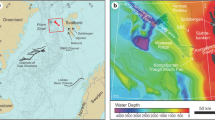Abstract
Much of the modern upper (proximal) Monterey fan is a channel–levee complex, the Upper Turbidite Sequence (UTS), that was deeply eroded after the channel breached a volcanic ridge to reach a deeper base level. Ages of sediment samples collected with the ALVIN submersible from the deepest outcrop within the channel–levee system, 390 m below the adjacent western levee crest, indicate that the UTS deposits accumulated at ≥1 m ka−1 during the last 500 ka. Neogene and Early Pleistocene sediment accumulation on the fan prior to the UTS was much slower (<0.03 m ka−1), and underlying turbidite systems(?) had substantially different morphologic expression(s).
Similar content being viewed by others
Author information
Authors and Affiliations
Rights and permissions
About this article
Cite this article
Normark, W.R. Late Pleistocene channel–levee development on Monterey submarine fan, central California. Geo-Marine Letters 18, 179–188 (1998). https://doi.org/10.1007/s003670050066
Received:
Revised:
Issue Date:
DOI: https://doi.org/10.1007/s003670050066




